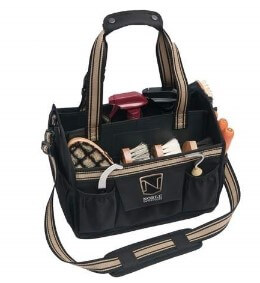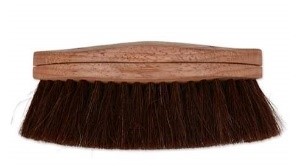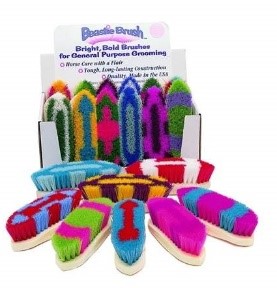Grooming is an essential part of horses’ daycare, so you should know how to do it properly. In addition, this routine is a great chance to make things work with your companion and build up a trusted and respectful relationship. In fact, getting along with your horse is crucial in horse riding so you can find a balance and control your horse’s moves duly. Apart from that, your companion will definitely be pleased with your lovely attention.
Want to find out more about grooming basics and its equipment? You’re just on the right track! Keep reading to broaden your horizons.
Grooming Tools

Grooming is grasped as a complex process, that’s why special gear is needed. Typically you can find an all-in-one horse grooming kit that consists of main tools. The number and design of the instruments may vary but generally, there are 7-8 tools included in a bundle. Here’s a list of substantial horse grooming tools that are needed to take care of your companion.
Bathing sponge
They could be of different sizes depending on purpose, whether you want to apply it for gentle zones like eyes, a nose, or lips, or bigger ones for entire body wash. The sponges can also be used to soak up extra water from the barrel and legs of a horse.


Grooming tote
If you buy a grooming set, it usually comes in a grooming tote. Typically it has a quite spacious design with plenty of pockets so you can store your grooming tools with no probs. And some extra space may be left for your equestrian gear. The bag is commonly made with a handle and / or a shoulder strap to carry the tote conveniently.
Hoof pick
It’s an essential tool that may vary in materials used and design but the purpose is one – to clean the hooves of a horse. With the use of a hoof pick, you can get rid of dirt and mud and ensure that everything is ok with hooves. That’s why it’s better to clean the hooves before and after horse riding. Some hoof picks come with a small brush that helps clean up the hooves immensely.


Mane and tail comb and brush
As humans brush their hair regularly, the same goes for horses’ manes and tails. That’s why you need a solid comb or brush. There are dozens of options presented on the market to fit any hair conditions. If your horse has a short mane, try using a wide-toothed brush. If your companion has long hair, it’s better to use a dandy brush. For those who have extra-long hair, owners prefer to brush the horse’s hair with their hands to avoid pulling the hair out.
Rubber curry comb
The comb is usually made of rubber but it can be plastic. It features small peaks all over the brush. The tool is used to get rid of dirt, mud, and hair. In addition, the “currying” fosters natural oil producing on the horse’s skin. For more sensitive skin or body zones, a grooming mitt may be used to avoid discomfort feelings when brushing.


Shedding blade
The tool is typically made of metal so it lasts for long. It comes with “teeth” on the metal part of the tool to improve shedding. So you can use the blade to deal with loose winter hair and dirt. In addition, the shedding blade can be used as a sweat scraper because of its multi-purpose design.
Soft brush
As its name says, the brush features soft bristles which could be either natural or synthetic. The soft brush is used to get rid of the dust and small bits of dirt as well as it makes the coat shiny. You can apply it for sensitive parts as the horse’s face and legs. But don’t forget to be careful and gentle when brushing. Alternatively, you can use just a piece of cloth to clean your horse’s face. In addition, smooth moves with the brush can provide a soothing effect which is a great plus.


Stiff brush, hard brush, or dandy brush
Unlike the soft brush, the hard brush is made with stiff bristles; both natural and synthetic bristles are available. Natural brushes are made with high quality though they last not so long. And synthetic brushes are more popular as they are more durable but not solid. Such brushes are used to get rid of the mud, dirt, and loose hair. Apply the tool in the direction of the growth of the horse’s hair. It’s not recommended to use the stiff brush on gentle parts of the body like the horse’s face.
Sweat scraper
As we mentioned before, the shedding blade can be used as a sweat scraper but there’s also a separable option. The sweat scraper on its own is used to get rid of sweat after intensive training or excess water after showering or in case if you get caught in the rain. The most common design is a rubber or plastic arch attached to a handle. Another design is far simpler, it’s just a curved plastic or metal stick. It’s generally used on the horse’s body, not on his face or legs.

As there’s a big range of various brushes of combs, a rookie horseman may end up feeling puzzled on how to use them properly and what the order is. That’s why we prepared detailed guidelines so you can be aware of the nitty-gritty of the grooming ritual.
How to Brush Your Horse – Step-by-Step Guide

When it’s time to brush your horse, you need the most part of your grooming tools. Different horsemen prefer sundry methods of brushing which they made up after continuous practice. Thus we’d like to introduce you to the common way of brushing a horse that you may find helpful.
As horses get dirty really quickly, especially if they spend lots of time in the open air in paddocks or pastures, you have to brush your companion frequently, at least before and after training.
- Start with the hooves. You need a hoof pick to get rid of the dirt, mud, and rocks. The best position to start is to come to the left side of a horse and face the back of a horse. So your left shoulder is next to the horse’s left shoulder. Ask your companion to lift his hoof and start picking. Don’t forget to scrap the triangular area underneath the hoof which is called the frog. But don’t touch the frog itself. When you finish the left front leg, switch to the left hind leg, the right hind leg, and then the right front leg. Examine each hoof to be sure that they are healthy.
- Grab the curry comb and move round and round over the horse’s coat to stir up the dirt and dust. Again start with the left side of a horse. It’s recommended to brush the body parts starting with the neck and moving to the back. The order is the following: the neck, chest, shoulders, back, belly, rump, and haunches. Be attentive with sensitive parts like legs and under the barrel, don’t press too hard. And it’s better to use a rubber brush for such zones. In addition, it’s recommended to stay while brushing to be ready to move away if your horse tries to kick you out.
- Next comes a stiff brush to remove the dirt accelerating on the coat. Do it with short moves starting from the neck on the left side. The order is like this, the neck, chest, shoulder, back, barrel, belly, rump, and haunches. Repeat the move on the right side. Don’t use a stiff brush on gentle parts like a face. And don’t forget to clean your brushes regularly so you the same bits of dirt don’t return to the horse.
- A soft brush comes after a hard brush to remove the rest of the dust. Apply the short-stroke moves for the left side of the neck. Then move to the chest, shoulder, back, barrel, belly, rump, and haunches. Repeat the same procedure on the right side of the horse. The coat starts shining. You can use a soft cloth to go through the coat to make it even shinier.
- While using a soft brush to clean the horse’s face, it’s better to use the cloth to clean the nostrils to make the moves more gentle. If it’s your first grooming, introduce your companion with the cloth first before you start cleaning.
- Take a soft brush to clean the horse’s head gently by moving with soft strokes. Don’t forget to introduce the brush to the horse before usage so he stays calm. That’s the most favorite part of grooming for horses as it brings a soothing effect.
- 7. It’s time to use a mane and tail comb and apply it by its nature of use. Move it gently and separate the tangles if needed. Brush the mane and tail in the direction of how the hair grows.
How to Wash Your Horse – Step-by-Step Guide

Another crucial horse grooming stage is washing bathing your companion. Unlike brushing, you don’t need to wash your horse on a daily basis. Two times a month will be enough to get your companion neat and tidy.
Before you start showering, you have to prepare the washing space. There must be a solid hitching post to tie your horse up. The floor has to be clean and non-slip before the procedure. Don’t forget about your bare essentials such as a sponge, bucket, shampoo and conditioner, and sweat scraper. And here’s the instruction on what you should do with all this stuff.
1. The best position to start is to come to the left side of a horse. It’s better to use a hosepipe for comfortable water-blast controlling. Water the horse’s legs first so he can get used to it. Shower and rinse your horse with warm water. If there’s no hose, use water from a bucket but this way is more time-consuming.
2. When your horse is ready to start taking a shower, start watering the neck, and then move smoothly to the back of a horse through the body. Don’t wet the horse’s head yet.
3. Grab some shampoo and apply it to the sponge and start lathering your companion. Again start from the neck and go across the body. Be careful when soaping gentle zones but watch all the dirt has to get away from the coat. Especially pay attention to the underbelly and back of your horse when the horse gear is typically tacked up. Don’t forget about the legs and hooves too.
4. When you get rid of the dirt and mud, it’s time to take a shower. Rinse the horse’s body with warm water to remove the shampoo. Do it thoroughly as soap leftovers may irritate the skin.
5. Switch to the horse’s mane. Use shampoo and conditioner to wash it up. Rinse the horse’s mane with warm water to remove the soap.
6. Repeat these steps to wash the right side of your horse.
7. Time to get the tail clean. Wet the tail and apply shampoo. Get all the dirt away from it. Rinse the tail and apply conditioner. Rinse again and do it thoroughly as soap leftovers may irritate the skin.
8. Move to the head. It’s a sensitive body so be careful and extremely gentle. Don’t point the blast of water to the horse’s face, use a sponge dipped in warm water to wet the face. Don’t forget about the forelock. It’s not recommended to use shampoo in order to avoid contact with eyes.
9. The final step is to help your horse to dry off. That’s why you need a sweat scraper. Remove excessive water from the body by using the scraper, moving it in the direction of the growth of horsehair. Wait till the horse dries off completely and then release him in the pasture. Great job, you did it!
Final Thoughts

Horses are demanding creatures that need to be treated well. If you want your companion to be healthy and promote his aging, you should always take care of him as parents look after their children. Thus we outlined major aspects of horse grooming so you’re aware of its techniques.
If you want to prolong your horse’s life and make it happier, check your companion’s well-being on a regular basis. No doubt, it might be challenging to take care of an animal a few times bigger and stronger than you. Particularly rookie horse owners may find it quite apprehensive. But all comes with experience, so just take a shot, and then you’ll see the process is not so overwhelming and what’s more, you may like it. In fact, soon after lots of horsemen end up enjoying grooming their horses as a blessing routing ritual.
As you can see, there’s a big array of grooming tools, specially designed for horses. All of them will come in handy when brushing and washing your companion. Here’s a detailed guide presented to help you get familiar with grooming basics so you treat your horse properly. Once you have a good command of grooming a horse, this ritual will bring pleasant moments both for you and your companion.
Image Source: blog.smartpakequine.com, horseyhooves.com.
